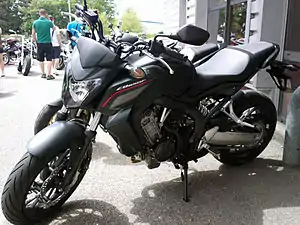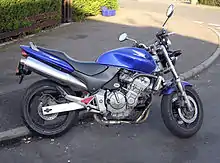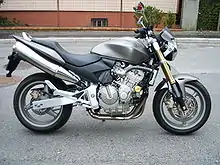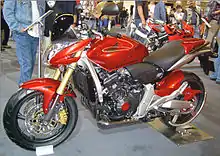Honda CB600F
The Honda CB600F (known as the Hornet in Europe and Brazil and 599 in the U.S.) is a standard motorcycle manufactured by Honda.[1][2][3] It is powered by a 599 cc (36.6 cu in) liquid-cooled inline-four engine, originally a detuned version of that in the Honda CBR600 sport bike, which currently produces around 102 bhp (76 kW). The 'Hornet' name was not taken to North America as AMC, and its successor, Chrysler, had trademarked the name with the AMC Hornet.
| Manufacturer | Honda |
|---|---|
| Also called | Honda Hornet (Europe and Brazil) Honda 599 (United States) |
| Production | 1998–2013 |
| Successor | Honda CB65 |
| Class | Standard |
| Engine | 599 cc (36.6 cu in), liquid cooled, inline four |
| Related | Honda CB900F Honda CBR600F3 Honda CBR600RR |
History
 | |
| Manufacturer | Honda |
|---|---|
| Production | 2014–2019 |
| Predecessor | Honda CB600F |
| Successor | Honda CB650R |
| Class | Standard |
| Engine | 648.7 cc (39.6 cu in) |
| Related | Honda CBR650F |
The Honda CB600F Hornet was introduced for Europe in 1998. It was based on the CB250F that was restricted to 250 cc (15 cu in) at its home-market (Japan) because of local laws (this bike was released only in Japan from 1996 or 1997 until 2015, when it was succeeded by the CB300F). The bike has a six-speed transmission. Its suspension consists of a single shock in the rear and a conventional telescopic fork in the front until it was succeeded by an upside-down fork in 2005. Its brakes are dual-disc, Nissin twin piston in the front and single-disc, Nissin single piston in the rear. It was given the 16 in (410 mm) diameter front wheel and 17 in (430 mm), 180 section rear wheel setup from the Fireblade.
As a sport-oriented motorcycle that provides an upright riding position, it is considered a standard or "naked bike".
In 2000, Honda updated the Hornet, changing the 16 in (410 mm) front wheel for a 17 in (430 mm) to help corner stability and increasing the strength of the brake pass-over system on the front, making the brakes stronger. However, Honda did not increase the size of the fuel tank. A faired version, the CB600FS, was also introduced in 2000.
In 2003, Honda gave the CB600F version a make-over, with a larger fuel tank (17 L or 3.7 imp gal or 4.5 US gal as opposed to the former 16 L or 3.5 imp gal or 4.2 US gal), and 'sharper' styling. The CB600S faired version was discontinued.
In 2005, the instrument cluster was modernised, and more importantly, it was fitted with inverted front forks, to improve road-holding and cornering stability.
Honda took the Hornet to the United States and Canadian market for the 2004 and 2006 model years. It was called the 599.
The highly revised CB600F model came out in April 2007. The engine of the new motorcycle is a detuned version of the engine available in the 2007 CBR600RR giving a maximum output power of approximately 102 bhp (76 kW).
In 2011, the model got a facelift. The headlight assembly was changed and the instrument cluster uses LCD display. This bike shared many of the same components – swingarm, fork, frame, engine – as the Honda CBR600F that was reintroduced in 2011.[4][5]
In 2014, the model received a major update and got a displacement increase of 49 cc, the new model is called CB650F.[6]
Specifications
1998-1999 |
2000-2002 |
2003-2006 |
2007–2013 |
2014–present | |
|---|---|---|---|---|---|
| Locations | |||||
| Model ID | Europe (CB600F Hornet) | Europe (CB600F Hornet) & North America (599) | Europe (CB650F) & North America (?) | ||
| Engine | |||||
| Engine Type | 599 cc (36.6 cu in) liquid-cooled 4-stroke 16-valve DOHC inline-4 | 648.7 cc (39.6 cu in) liquid-cooled 4-stroke 16-valve DOHC inline-4 | |||
| Bore/Stroke | 65.0 mm × 45.2 mm (2.56 in × 1.78 in) | 67.0 mm × 42.5 mm (2.64 in × 1.67 in) | 67.0 mm × 46.0 mm (2.6 in × 1.8 in) | ||
| Compression Ratio | 12.0:1 | 11.4:1 | |||
| Max Power Output | 94.69 bhp (70.61 kW) at 12,000 rpm | 94 bhp (70 kW) at 12,000 rpm | 96.5 bhp (72.0 kW) at 12,000 rpm 80.4 hp (60.0 kW)(rear wheel)[7] |
102 bhp (76 kW) at 12,000 rpm | 85.8 hp (64.0 kW) @ 11,000 rpm[6] |
| Max Torque | 46.3 lbf⋅ft (62.76 N⋅m) @ 9,500 rpm | 45.6 lbf⋅ft (61.78 N⋅m) @ 10,000 rpm | 46.5 lbf⋅ft (63 N⋅m) @ 10,000 rpm 41.7 lb⋅ft (56.5 N⋅m) (rear wheel)[7] |
46.8 lbf⋅ft (63.5 N⋅m) @ 10,500 rpm | 46.5 lbf⋅ft (63 N⋅m) @ 8,000 rpm (claimed)[6] |
| Valve Train | DOHC; four valves per cylinder | ||||
| Carburetion | Four 34.0 mm (1.34 in) slanted flat-slide CV | PGM-FI electronic fuel injection | PGM-FI electronic fuel injection | ||
| Ignition | Computer-controlled digital with electronic advance | Computer-controlled digital transistorised with electronic advance | |||
| Drivetrain | |||||
| Transmission | Six-speed | ||||
| Final Drive | #525 O-ring-sealed chain | ||||
| Chassis/Suspension/Brakes | |||||
| Front Suspension | 41 mm (1.6 in) telescopic fork; 125 mm (4.9 in) travel | 41 mm (1.6 in) telescopic fork; 120 mm (4.7 in) travel | 41 mm (1.6 in) inverted telescopic fork | 41 mm (1.6 in) Telescopic fork; 109.2 mm (4.3 in) travel | |
| Rear Suspension | Single shock with seven-position spring-preload adjustability; 128 mm (5.0 in) travel | Single shock with spring-preload adjustability; 127.0 mm (5.0 in) travel | |||
| Front Brakes | Dual full-floating 296 mm (11.7 in) discs with twin-piston calipers. | Dual full-floating 296 mm (11.7 in) discs with twin-piston calipers. ABS optional. | Two-piston calipers with dual 320 mm (12.6 in) discs | ||
| Rear Brakes | Single 220 mm (8.7 in) disc with single-piston caliper. | Single 240 mm (9.4 in) disc with single-piston caliper. ABS optional. | Single-caliper 240 mm (9.4 in) disc | ||
| Front Tire | 130/70ZR16 | 120/70ZR-17 radial | |||
| Rear Tire | 180/55ZR-17 radial | ||||
| Dimensions | |||||
| Rake | 25.5 degrees | 25 degrees | 25.5° | ||
| Trail | 96.0 mm (3.78 in) | 99.0 mm (3.90 in) | 101.3 mm (4.0 in) | ||
| Wheelbase | 1,419.86 mm (55.900 in) | 1,424.94 mm (56.100 in) | 1,419.86 mm (55.900 in) | 1,435.1 mm (56.50 in) | 1,450 mm (57.1 in) |
| Seat Height | 795 mm (31.3 in) | 795–790 mm (31.3–31.1 in) | 800 mm (31 in) | 810 mm (32 in) | |
| Dry Weight | 176 kg (388 lb) | 176–181 kg (388–399 lb) | 173 kg (381 lb) | ||
| Wet Weight | 202 kg (446 lb)[7] | 208 kg (459 lb)[6] | |||
| Fuel Capacity | 16 L (3.5 imp gal; 4.2 US gal) | 17 L (3.7 imp gal; 4.5 US gal) | 19 L (4.2 imp gal; 5.0 US gal) | 17.3 L (4.6 US gal) | |
See also
Notes
- Hill, Geoff (2010-01-31), "TRY THIS NAKED BEAUTY, VIRGIN RIDERS. Yamaha's stripped-down XJ6 is ideal for beginners to build up their confidence on", Sunday Times, London (UK), p. 8, retrieved 2010-12-26
- Anonymous (Apr 21, 2010), "Spring deals on Honda's range", Cornish Guardian, Truro (UK), p. 31
- "Honda CB600F Hornet: A dashingly styled machine", Belfast Telegraph, Belfast, p. 1, Mar 7, 2007
- Ets-Hokin, Gabe (November 18, 2010). "What You Can't Have: 2011 Honda CBR600F". Motorcycle Daily.com. Retrieved September 11, 2016.
- Falconer, Mel (June 17, 2011). "Road Test: 2011 Honda CBR600F ABS and 2004 Honda CBR600F - Sibling rivalry". Motorcycle Monthly. Archived from the original on August 11, 2016. Retrieved September 11, 2016.
- "Specifications". Honda. Honda. Retrieved 1 August 2016.
- "Performance Index Winter '12/'13 Edition" (PDF), Motorcycle Consumer News, Bowtie Magazines, January 2013, archived from the original (PDF) on 2016-12-29